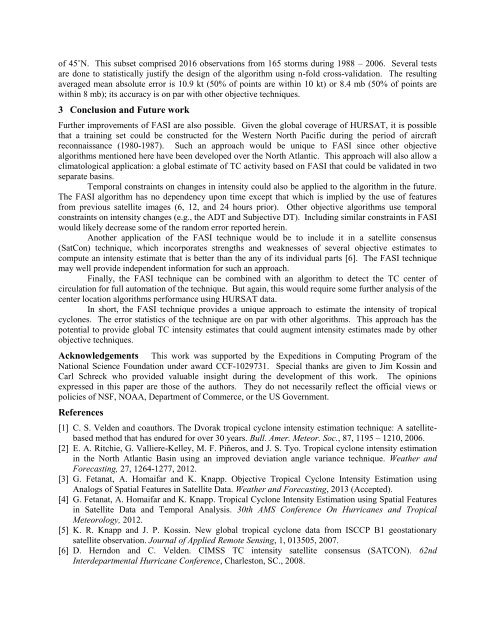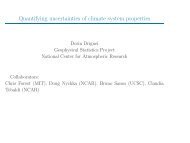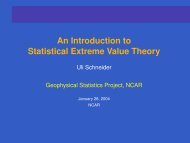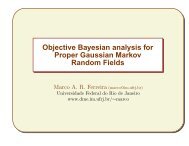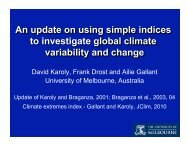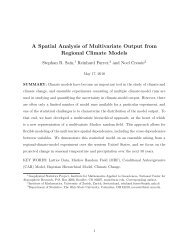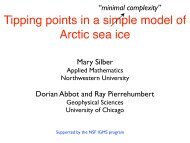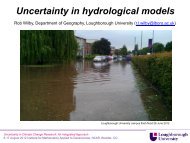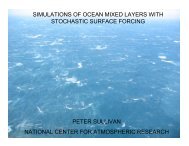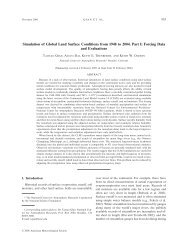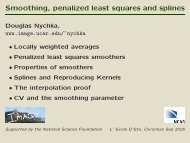Objective Tropical Cyclone Intensity Estimation from Satellite Images ...
Objective Tropical Cyclone Intensity Estimation from Satellite Images ...
Objective Tropical Cyclone Intensity Estimation from Satellite Images ...
Create successful ePaper yourself
Turn your PDF publications into a flip-book with our unique Google optimized e-Paper software.
of 45˚N. This subset comprised 2016 observations <strong>from</strong> 165 storms during 1988 – 2006. Several tests<br />
are done to statistically justify the design of the algorithm using n-fold cross-validation. The resulting<br />
averaged mean absolute error is 10.9 kt (50% of points are within 10 kt) or 8.4 mb (50% of points are<br />
within 8 mb); its accuracy is on par with other objective techniques.<br />
3 Conclusion and Future work<br />
Further improvements of FASI are also possible. Given the global coverage of HURSAT, it is possible<br />
that a training set could be constructed for the Western North Pacific during the period of aircraft<br />
reconnaissance (1980-1987). Such an approach would be unique to FASI since other objective<br />
algorithms mentioned here have been developed over the North Atlantic. This approach will also allow a<br />
climatological application: a global estimate of TC activity based on FASI that could be validated in two<br />
separate basins.<br />
Temporal constraints on changes in intensity could also be applied to the algorithm in the future.<br />
The FASI algorithm has no dependency upon time except that which is implied by the use of features<br />
<strong>from</strong> previous satellite images (6, 12, and 24 hours prior). Other objective algorithms use temporal<br />
constraints on intensity changes (e.g., the ADT and Subjective DT). Including similar constraints in FASI<br />
would likely decrease some of the random error reported herein.<br />
Another application of the FASI technique would be to include it in a satellite consensus<br />
(SatCon) technique, which incorporates strengths and weaknesses of several objective estimates to<br />
compute an intensity estimate that is better than the any of its individual parts [6]. The FASI technique<br />
may well provide independent information for such an approach.<br />
Finally, the FASI technique can be combined with an algorithm to detect the TC center of<br />
circulation for full automation of the technique. But again, this would require some further analysis of the<br />
center location algorithms performance using HURSAT data.<br />
In short, the FASI technique provides a unique approach to estimate the intensity of tropical<br />
cyclones. The error statistics of the technique are on par with other algorithms. This approach has the<br />
potential to provide global TC intensity estimates that could augment intensity estimates made by other<br />
objective techniques.<br />
Acknowledgements This work was supported by the Expeditions in Computing Program of the<br />
National Science Foundation under award CCF-1029731. Special thanks are given to Jim Kossin and<br />
Carl Schreck who provided valuable insight during the development of this work. The opinions<br />
expressed in this paper are those of the authors. They do not necessarily reflect the official views or<br />
policies of NSF, NOAA, Department of Commerce, or the US Government.<br />
References<br />
[1] C. S. Velden and coauthors. The Dvorak tropical cyclone intensity estimation technique: A satellitebased<br />
method that has endured for over 30 years. Bull. Amer. Meteor. Soc., 87, 1195 – 1210, 2006.<br />
[2] E. A. Ritchie, G. Valliere-Kelley, M. F. Piñeros, and J. S. Tyo. <strong>Tropical</strong> cyclone intensity estimation<br />
in the North Atlantic Basin using an improved deviation angle variance technique. Weather and<br />
Forecasting, 27, 1264-1277, 2012.<br />
[3] G. Fetanat, A. Homaifar and K. Knapp. <strong>Objective</strong> <strong>Tropical</strong> <strong>Cyclone</strong> <strong>Intensity</strong> <strong>Estimation</strong> using<br />
Analogs of Spatial Features in <strong>Satellite</strong> Data. Weather and Forecasting, 2013 (Accepted).<br />
[4] G. Fetanat, A. Homaifar and K. Knapp. <strong>Tropical</strong> <strong>Cyclone</strong> <strong>Intensity</strong> <strong>Estimation</strong> using Spatial Features<br />
in <strong>Satellite</strong> Data and Temporal Analysis. 30th AMS Conference On Hurricanes and <strong>Tropical</strong><br />
Meteorology, 2012.<br />
[5] K. R. Knapp and J. P. Kossin. New global tropical cyclone data <strong>from</strong> ISCCP B1 geostationary<br />
satellite observation. Journal of Applied Remote Sensing, 1, 013505, 2007.<br />
[6] D. Herndon and C. Velden. CIMSS TC intensity satellite consensus (SATCON). 62nd<br />
Interdepartmental Hurricane Conference, Charleston, SC., 2008.


